Sir John Monash, Personal Files Book 14, 10 February - 30 March 1917, Part 8
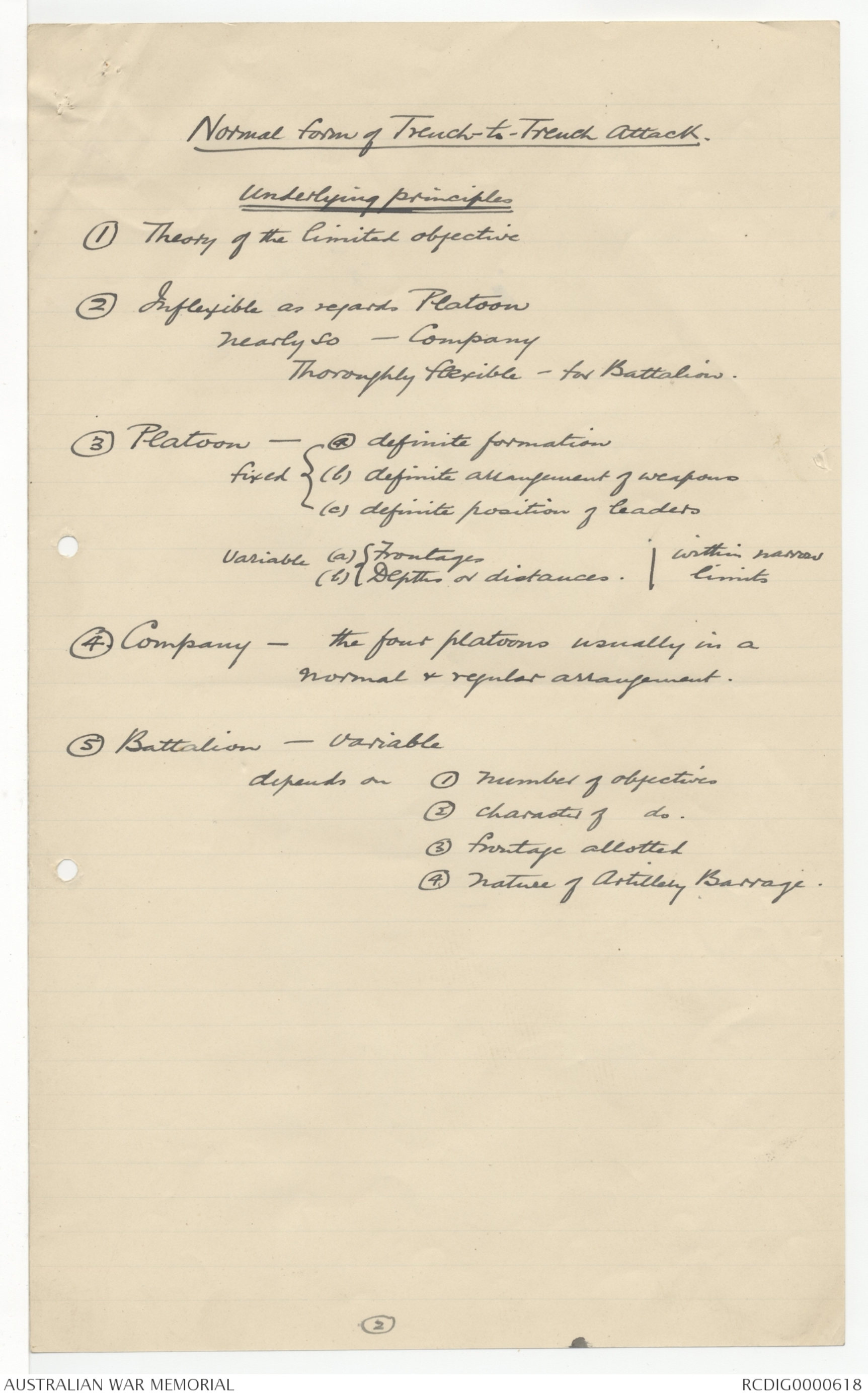
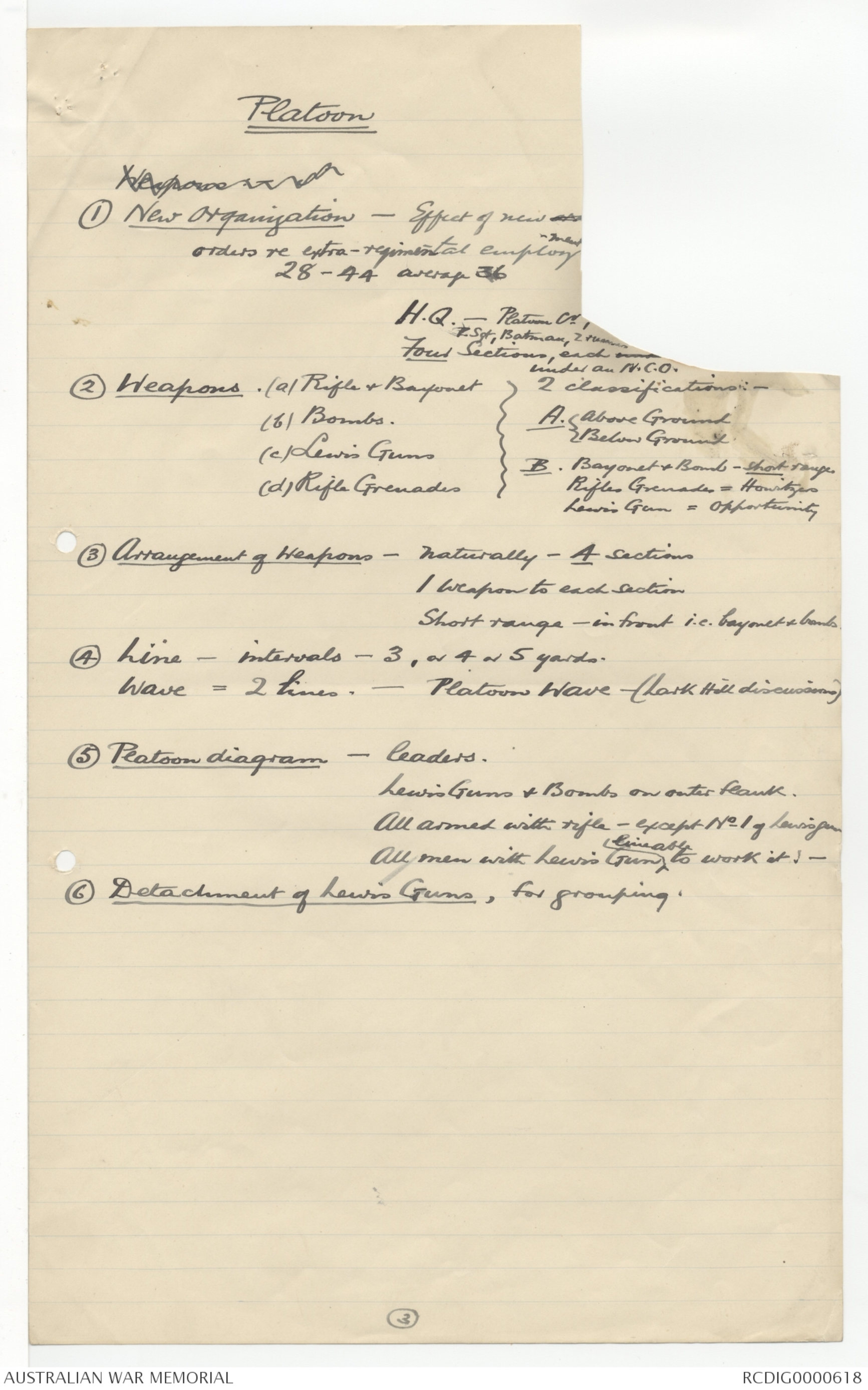
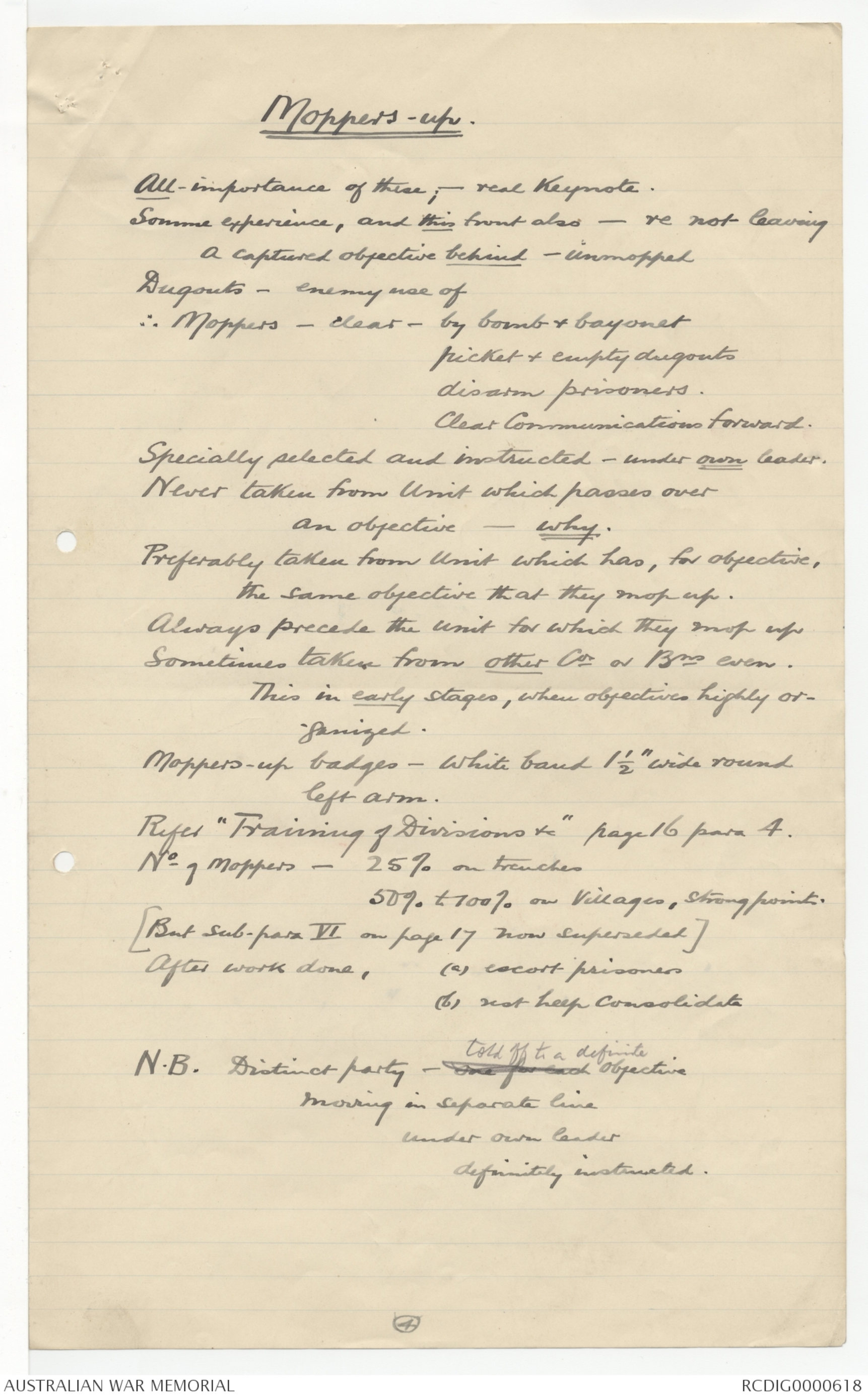
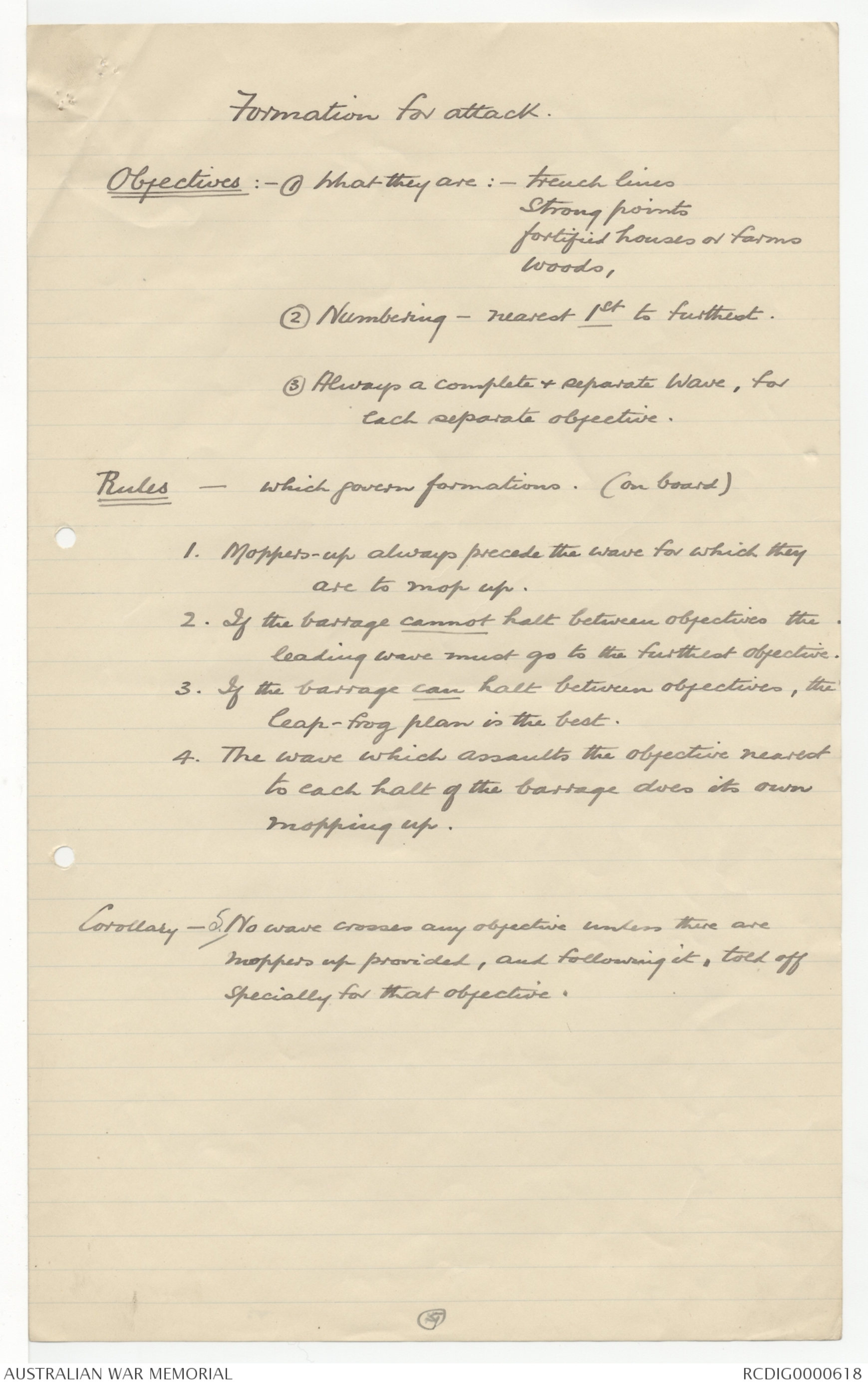
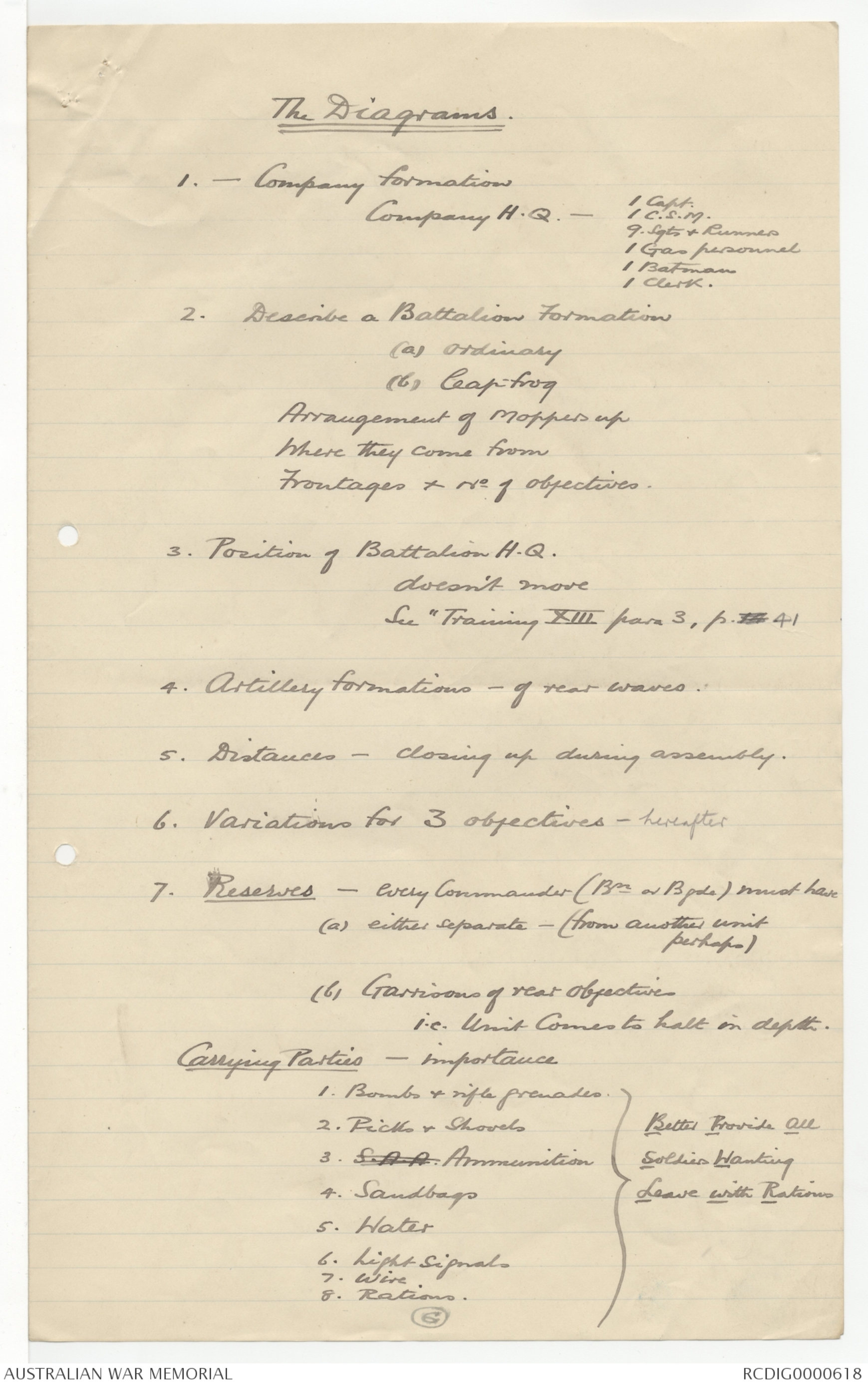
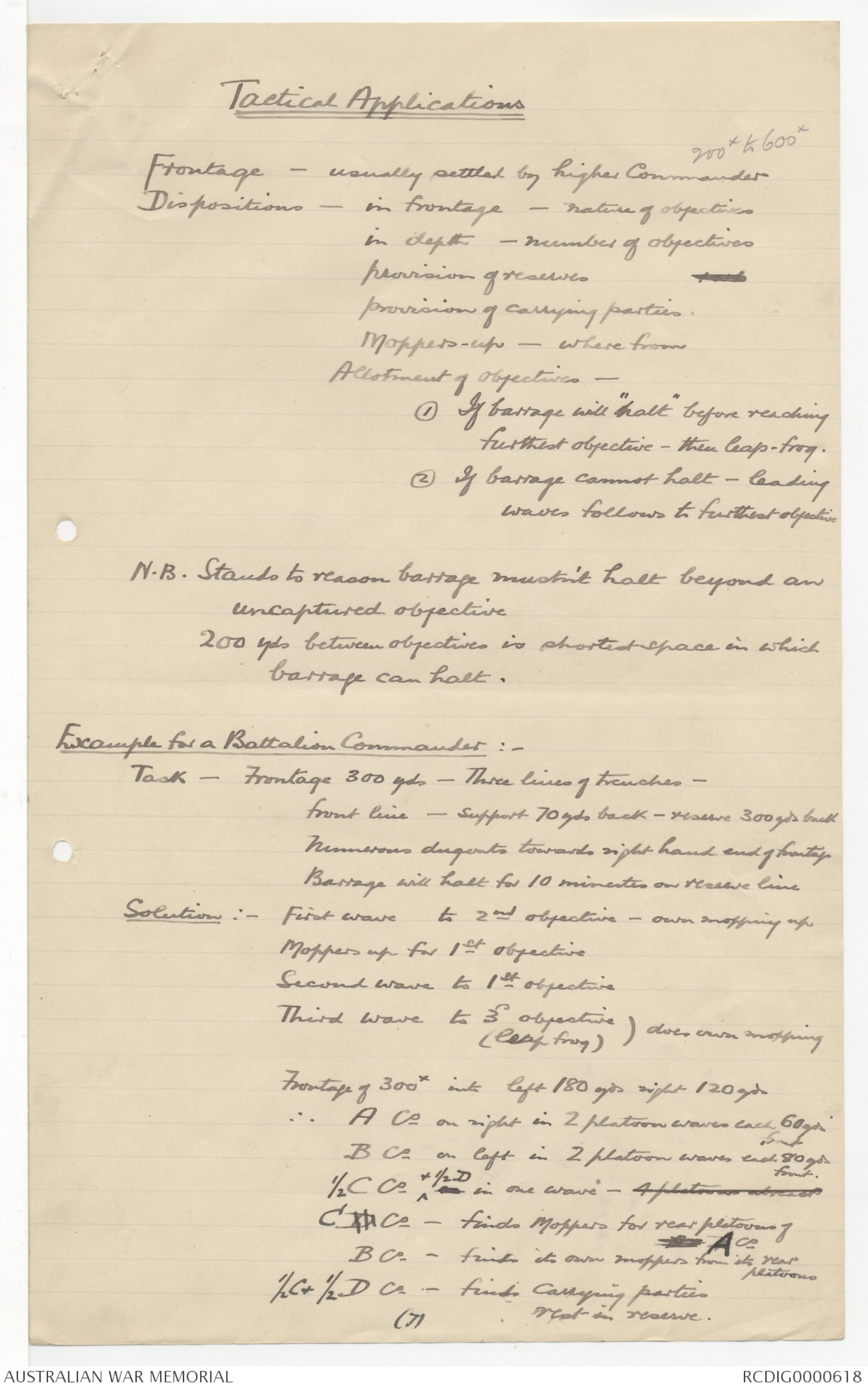
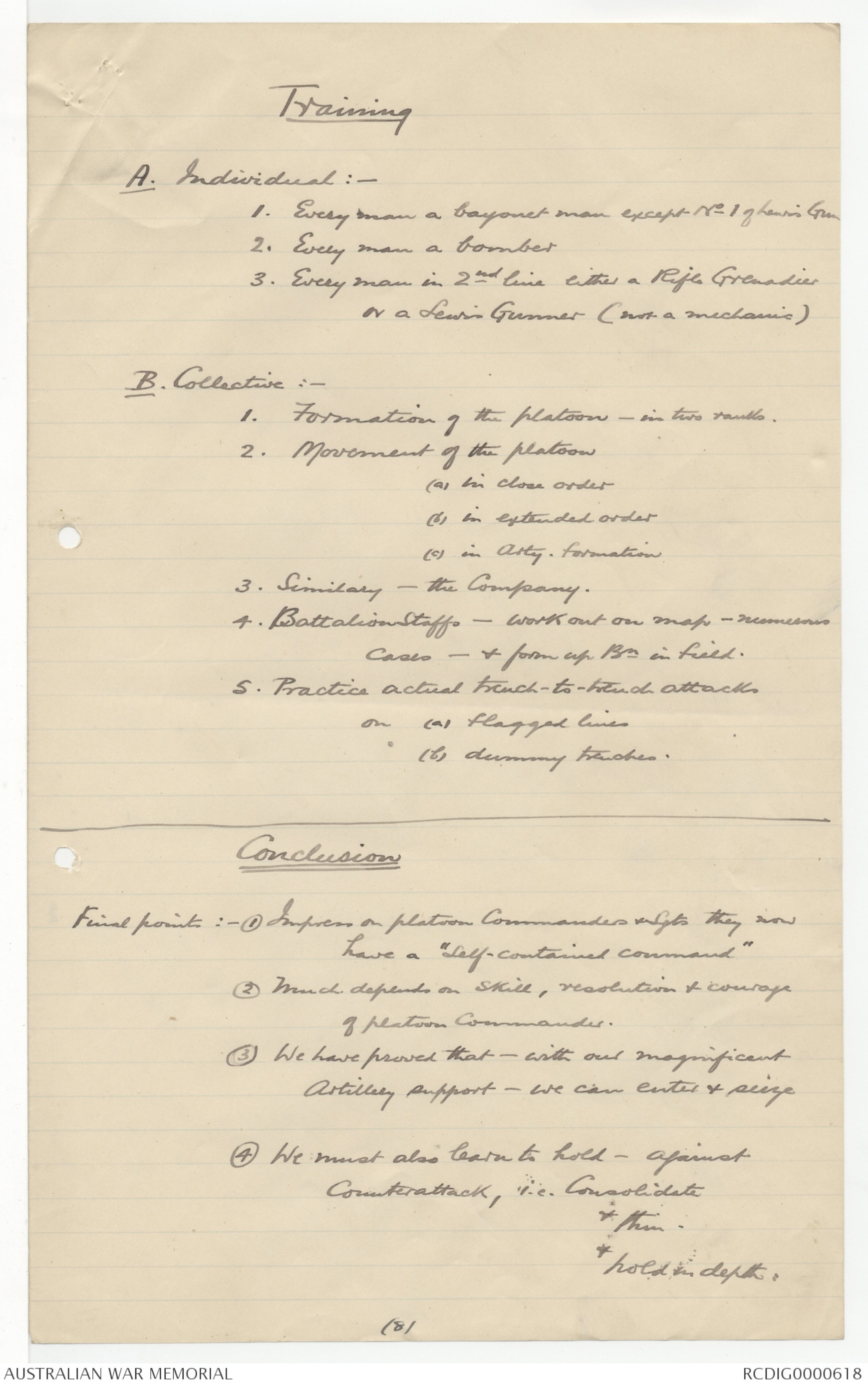
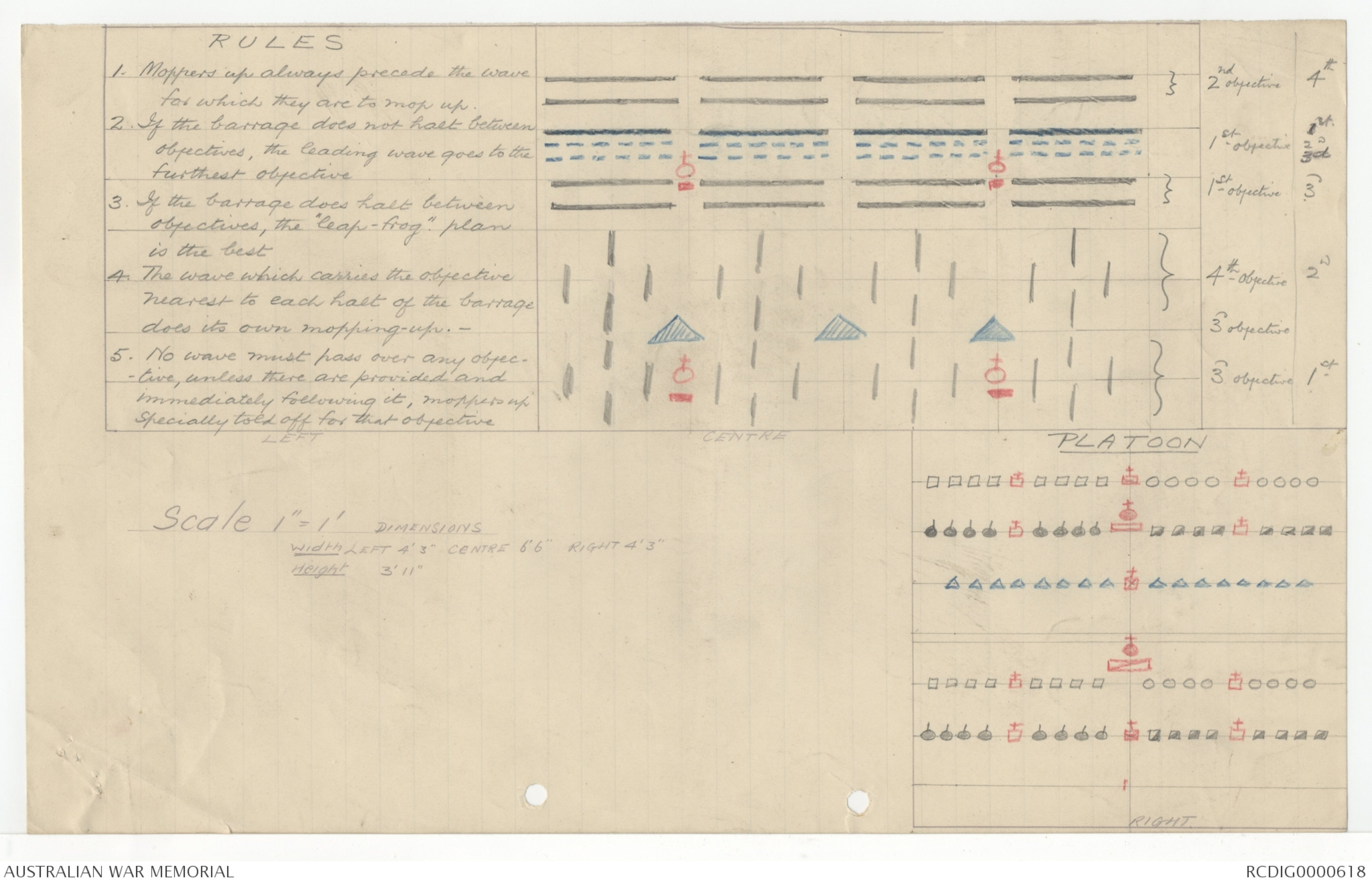
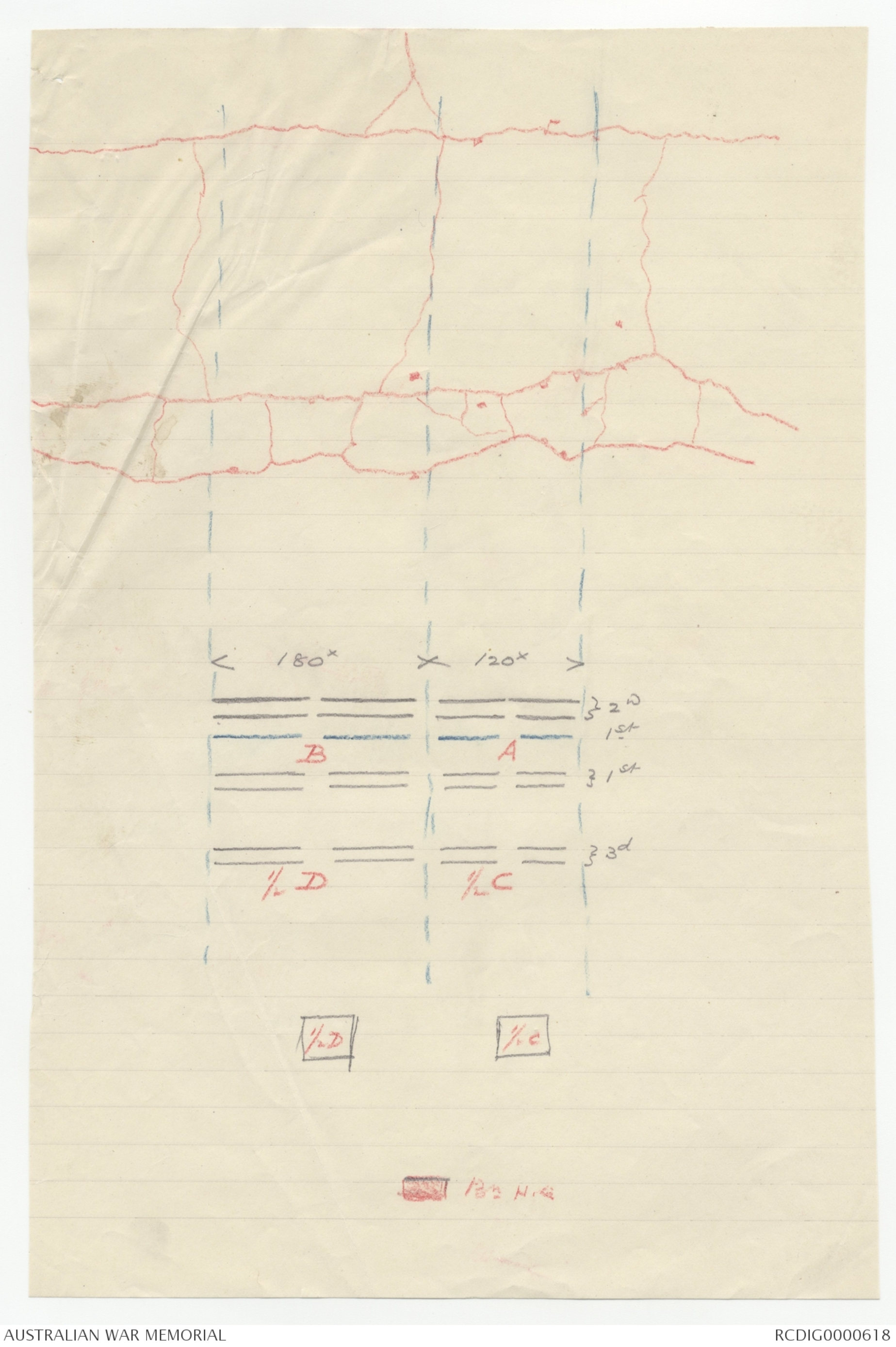
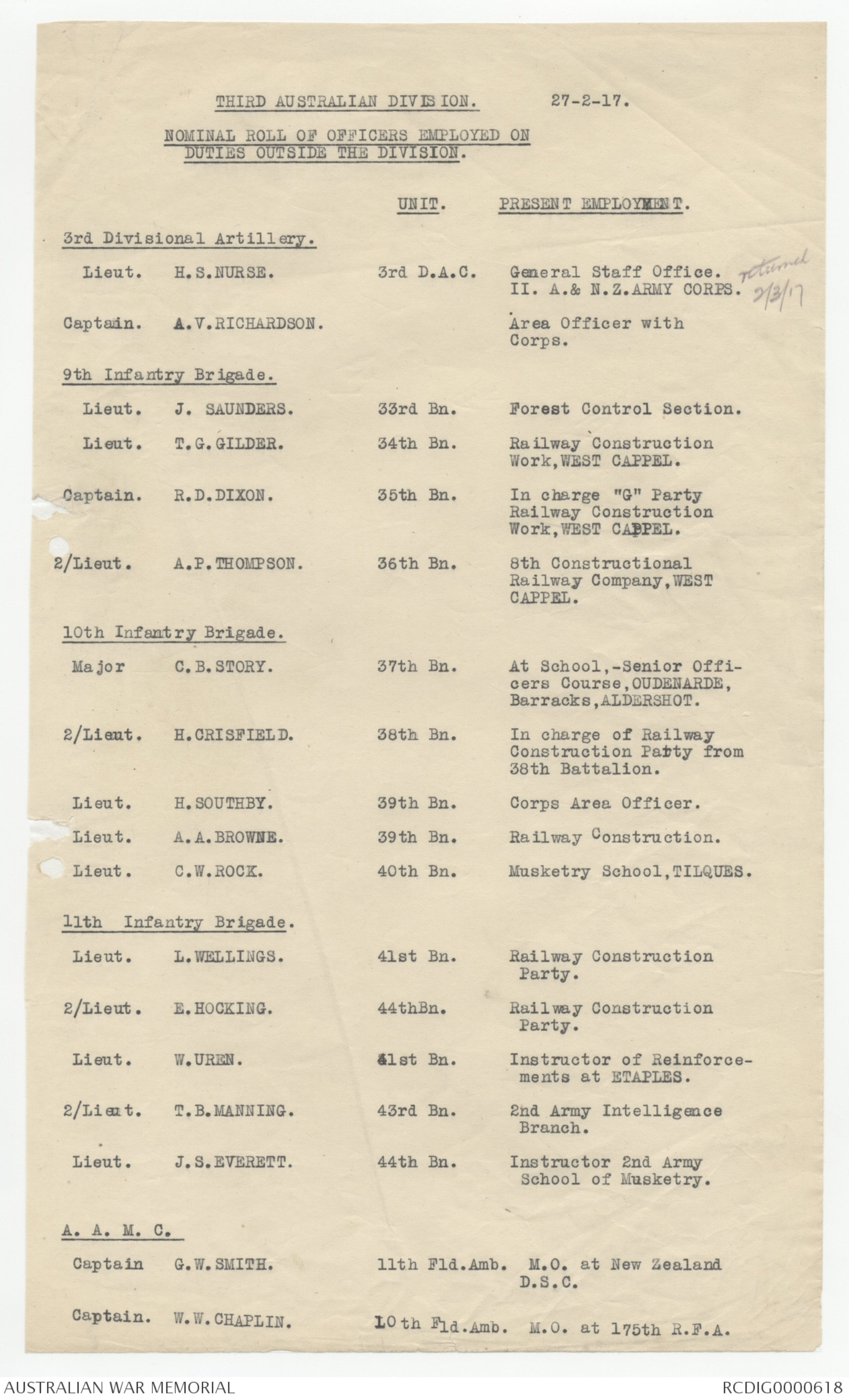
Normal form of Trench-to-Trench attack.
Underlying principles
(1) Theory of the limited objective
(2) Inflexible as regards Platoon
nearly so - Company
Thoroughly flexible - for Battalion.
(3) Platoon - { (a) definite formation
Fixed { (b) definite arrangement of weapons
{ (c) definite position of leaders
Variable (a) Frontages | within narrow
(b) Depths or distances. | limits
(4) Company - the four platoons usually in a
normal & regular arrangement
(5) Battalion - variable
depends on
(1) Number of objectives
(2) Character of do.
(3) Frontage allotted
(4) Nature of artillery Barrage
(2)
Platoon
Weapons n- rd
(1) New Organization - Effect of new xxx
orders re extra-regimental employment ~ new
28-44 average 36
H.Q. - Platoon Cn
R. Sgt, Batman, 2 runners
Four Sections, each annds
under an N.C.O.
(2) Weapons.
(a) Rifle & Bayonet } 2 classifications:-
(b) Bombs. } A. {Above Ground
} { Below Ground
(c) Lewis Guns } B. Bayonet & Bomb -short range
d) Rifle Grenades } Rifle Grenades = Howitzers
} Lewis Gun = opportunity
(3) Arrangement of Weapons -
Naturally - 4 sections
1 weapon to each section
Short range - in front i.e. bayonet & bomb
(4) Line - intervals - 3, or 4 or 5 yards.
Wave = 2 Lines. - Platoon Wave -(Lark Hill discussions)
(5) Platoon diagram - leaders.
Lewis Guns & Bombs on outer flank.
All armed with rifle - except No 1 of Lewis gun
All men with Lewis gun ^line able to work it:-
(5) Detachment of Lewis Guns , for grouping.
3
Moppers-up.
All - importance of these, - real Keynote.
Somme experience, and this front also - re not leaving
a captured objective behind - unmopped
Dugouts - enemy use of
∴ Moppers - clear - by bomb and bayonet
picket and empty dugouts
disarm prisoners.
Clear Communications forward.
Specially selected and instructed - under own leader.
Never taken from Unit which passes over
an objective - why.
Preferably taken from Unit which has, for objective,
the same objective that they mop up.
Always precede the unit for which they mop up.
Sometimes taken from other Con or Bns even.
This in early stages, when objectives highly organized.
Moppers-up badges - White bank 1½" wide round
left arm.
Refer "Training of Divisions &c " page 16 para 4.
No of Moppers - 25% on trenches
50% to 100% on Villages, strong points.
[But Sub-para VI on page 17 now superseded]
After work done, (a) escort prisoners
(b) rest help consolidate
N.B. Distinct party - one for each told off to a definite objective
moving in separate line
under own leader
definitely instructed.
4
Formation for attack.
Objectives :-
1. What they are:- trench lines
strong points
fortified houses or farms
woods,
2. Numbering - nearest 1st to furthest.
3. Always a complete & separate Wave, for
each separate objective.
RULES - which govern formations. (on board)
1. Moppers-up always precede the wave for which they
are to mop up.
2. If the barrage cannot halt between objectives the
leading wave must go to the furthest objective.
3. If the barrage can halt between objectives, the
leap-frog plan is the best.
4. The wave which assaults the objective nearest
to each halt of the barrage does its own
mopping up.
COROLLARY -5 No wave crosses any objective unless there are
moppers up provided, and following it, told off
specially for that objective.
5
The Diagrams
1. Company formation
Company H.Q. - 1 Capt.
1 C.S.M
9. Sgts & Runners
1 Gas personnel
1 Batman
1 Clerk
2. Describe a Battalion Formation
(a) ordinary
(b) leap-frog
Arrangements of Moppers up
Where they come from
Frontages & No of objectives.
3. Position of Battalion H.Q
doesn't move
See "Training XIII para 3, p xx 41
4. Artillery formations - of new waves
5. Distances - closing up during assembly.
6. Variations for 3 objectives - hereafter
7. Reserves - every Commander (Bn or Bgde) must have
(a) either separate - (from another unit
perhaps )
(b) Garrisons of rear objectives
i.e. Unit Comes to halt in depth.
Carrying Parties - importance
1. Bombs & rifle grenades }
2. Picks & Shovels } Better Provide All
3. S.A.A. Ammunition } Soldiers Wanting
4. Sandbags } Leave with Rations
5. Water }
6. Light Signals. }
7. Wire. }
8. Rations. }
5
Tactical Applications
[*200* to 600**]
Frontage - usually settled by higher Commander
Dispositions - in frontage - nature of objectives
in depth - number of objectives
provision of reserves xxxx
provision of carrying parties
Moppers-up - where from
Allotment of objectives -
(1) If barrage will "halt" before reaching
furthest objective - then leap-frog.
(2) If barrage cannot halt - leading
waves to follows to furthest objective
N.B. Stands to reason barrage mustn't halt beyond an
uncaptured objective
200 yds between objectives is shortest space in which
barrage can halt.
Example for a Battalion Commander:-
Task - Frontage 300 yds - Three lines of trenches -
front line - support 70 yds back - reserve 300 yds back
Numerous dugouts towards right hand end of frontage
Barrage will halt for 10 minutes on reserve line
Solution:- First wave to 2nd objective - own mopping up
Moppers- up for 1st objective
Second wave to 1st objective
Third wave to 3rd objective
(leap-frog) ) does own mopping
Frontage of 300x into left 180 yds right 120 yds
∴ A Co on right in 2 platoon waves each 60 yds
front
B Co on left in 2 platoon waves each 80 yds
front
½C Co ∧ & ½D in one wave - 4 platoons abreast
CD Co - finds Moppers for rear platoons of
B Co - finds its own moppers from its rear
platoons
½C & ½D Co - finds carrying parties
rest in reserve
7
Training
A. Individual:-
1. Every man a bayonet man except No 1 of Lewis Gun
2. Every man a bomber
3. Every man in 2nd line either a Rifle Grenadier
or a Lewis Gunner (not a mechanic)
B. Collective:-
1. Formation of the platoon - in two ranks.
2. Movement of the platoon
(a) in close order
(b) in extended order
(c) in Arty. formation
3. Similarly - the Company.
4. Battalion Staffs - work out on map - numerous
Cases - & form up Bn in field.
5. Practice actual trench-to-trench attacks
on (a) flagged lines
(b) dummy trenches.
Conclusion
Final points:- (1) Impress on platoon Commanders & Sgts they now
have a "Self-contained command"
(2) Much depends on Skill, resolution & courage
of platoon Commander.
(3) We have proved that - with our magnificent
Artillery support - we can enter and seize
(4) We must also learn to hold - against
Counterattack, i.e. Consolidate
&thin
& hold in depth.
8
RULES
1. Moppers always precede the wave
for which they are to mop up
2. If the barrage does not halt between
objectives, the leading wave goes to the
furtherest objective
3. If the barrage does halt between objective
the “leap - frog” plan
is the best
4. The wave which carries the objective
nearest to each halt of the barrage
does it’s own mopping up -
5. No wave must pass over any objective
unless there are provided and
immediately following it, moppers up
specially told off for that objective
Diagram, see original document
Diagram-see original document
THIRD AUSTRALIAN DIVISION
NOMINAL ROLL OF OFFICERS EMPLOYED ON
DUTIES OUTSIDE THE DIVISION
UNIT PRESENT EMPLOYMENT
3rd Divisional Artillery.
Lieut. H.S. NURSE 3rd D.A.C. General Staff Office [*returned 2/3/17*]
Captain A.V. RICHARDSON Area Officer with Corps.
9th Infantry Brigade.
Lieut. J. SAUNDERS. 33rd Bn. Forest Control Section
Lieut. T. G. GILDER. 34th Bn. Railway Construction
Work, WEST CAPPEL.
Captain. R. D. DIXON. 35th Bn. In charge “G” Party
Railway Construction
Work, WEST CAPPEL
2/ Lieut. A. P THOMPSON 36th Bn. 8th Constructional
Railway Company, WEST
CAPPEL.
10th Infantry Brigade.
Major C. B. STORY. 37th Bn. At School -Seniors Officers
Course, OUDENARDE,
Barracks, ALDERSHOT.
2/ Lieut. H. CRISFIELD. 38th Bn. In charge of Railway
Construction Party from
38th Battalion.
Lieut. H. SOUTHBY. 39th Bn. Corps Area Officer.
Lieut. A. A. BROWNE. 39th Bn. Railway Construction.
Lieut. C. W. Rock. 40th Bn. Musketry School, TILQUES.
11th Infantry Brigade.
Lieut. L. WELLINGS. 41st Bn. Railway Construction
Party.
2/Lieut. E. HOCKING. 44thBn. Railway Construction
Party.
Lieut. W. UREN. 41st Bn. Instructor of reinforcements
at EYTAPLES.
2/Lieut. T. B. MANNING. 43rd Bn. 2nd Army Intelligence
Branch.
Lieut. J. S. EVERETT. 44th Bn. Instructor 2nd Army
School of Musketry.
A. A. M. C.
Captain G. W. SMITH. 11th Fld. Amb. M.O. at New Zealand
D. S. C.
Captain. W. W. CHAPLIN. 10th Fld. Amb. M.O. at 175th R. F. A.
 Sandy Mudie
Sandy MudieThis transcription item is now locked to you for editing. To release the lock either Save your changes or Cancel.
This lock will be automatically released after 60 minutes of inactivity.